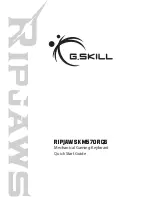
12-10
Triple Modular Processing
Editing Triples
New Combinations of DSP Functions
Seven new two-stage DSP functions combine a
fi
lter or double shaper with a gain function (the
gain occurs
after
the
fi
ltering/shaping). One or more of these functions is available in most of the
two-stage DSP blocks. They’re listed below.
These functions are equivalent to two single-stage blocks in a v1.0 algorithm—a block using a
fi
lter or shaper followed by a block using the GAIN function.
Stereo Keymaps
Because of sound-processing requirements, triples can’t use stereo keymaps. Consequently,
there’s no Stereo parameter on the Keymap page when any layer of a triple is the current layer.
Programs that use both triples and normal layers can use stereo keymaps for the normal layers.
Note Stealing in Triples
When you exceed the 48-voice polyphonic limit, the K2661 uses the AMPENV-page settings for
Layer 3 of a triple to determine how the voices from that triple get stolen. Consequently, if you
want to change how the triple’s notes get stolen, you should edit the parameters on the
AMPENV page for Layer 3 of the triple (as opposed to editing the AMPENV parameters for
Layers 1 or 2). For example, decreasing the duration of the decay and/or release segments
reduces your polyphony requirements.
Using DSP Waveforms
Keep in mind that the DSP waveforms (like SINE, SQR, SAW, and NOISE are typically 5 to 6 dB
hotter than ROM samples. This can cause clipping in some of the
fi
lters used in triple
algorithms. Consequently, you may want to reduce the input levels for
fi
lters that are processing
DSP waveforms.
Using PWM
DSP blocks that use the PWM function are meant to be followed by blocks using the DIST
function (this is true for normal VAST layers, as well). See your Musician’s Guide for more
information.
Using NOISE+
The DSP function called NOISE+ is available for many one-stage DSP blocks in Layer-2 and
Layer-3 algorithms. This provides a convenient way to add noise at one or more points in a
triple. When you use this function in a DSP block, it adds nearly-white noise—that is, an audio
signal with nearly equal amplitude at all audible frequencies—to the existing signal (unless the
existing signal has zero amplitude, in which case no noise gets added).
LOPAS2 GAIN
LP2RES GAIN
HIPAS2 GAIN
SHAPE2 GAIN
BAND2 GAIN
LPGATE GAIN
NOTCH2 GAIN
Содержание K2661
Страница 18: ...2 4 LFOs LFO Shapes...
Страница 34: ...3 16 DSP Algorithms...
Страница 54: ...5 4 MIDI Note Numbers Note Numbers for Percussion Keymaps...
Страница 72: ...7 10 System Exclusive Protocol K2661 System Exclusive Implementation...
Страница 82: ...9 4 Upgrading Sample Memory Choosing and Installing a SIMM for K2661 Sample Memory...
Страница 334: ...10 252 KDFX Reference KDFX Algorithm Specifications...
Страница 340: ...11 6 Glossary...
Страница 382: ...12 42 Triple Modular Processing Alphanumeric Buttonpad Entries for DSP Functions...
Страница 392: ...B 6 SysEx Control of KDFX MSB and LSB...
Страница 442: ...D 20 Contemporary ROM Block Objects Controller Assignments Contemporary ROM Block...
Страница 490: ...H 12 General MIDI Standard Mode Controller Assignments...
Страница 492: ...I 2 Live Mode Objects Live Mode Programs...
Страница 498: ...K2661 Musician s Reference Index...
Страница 500: ......
















































